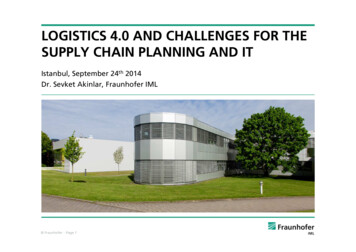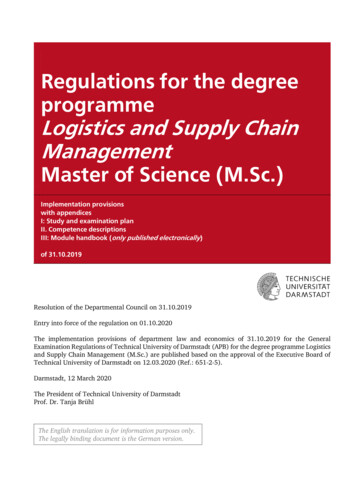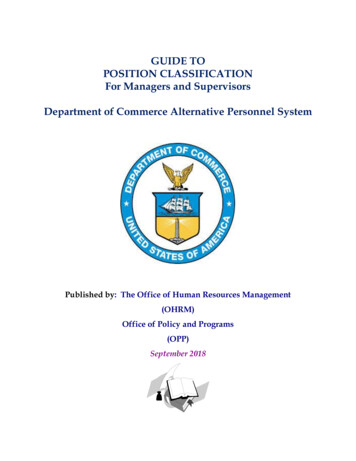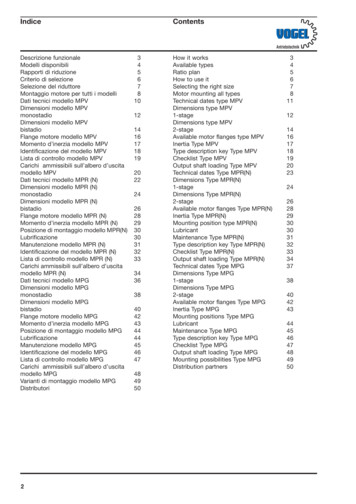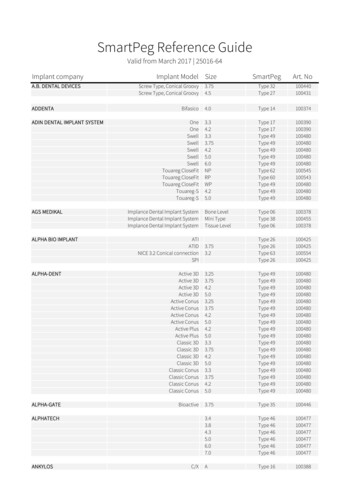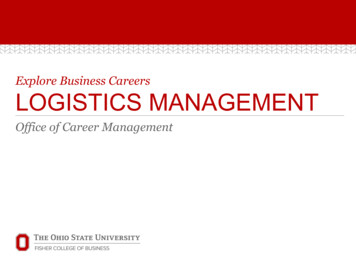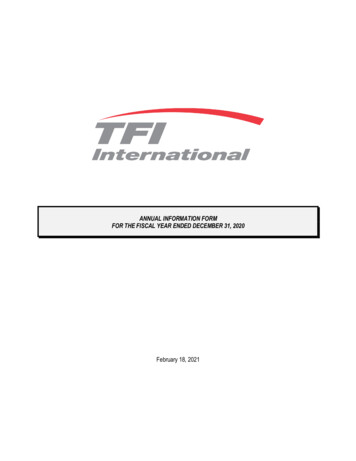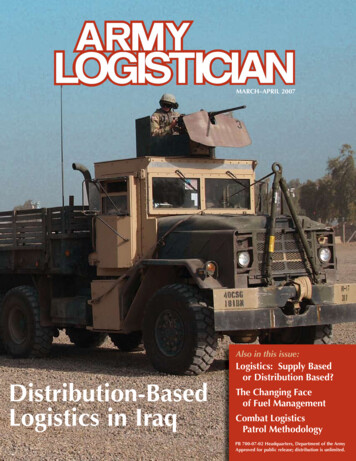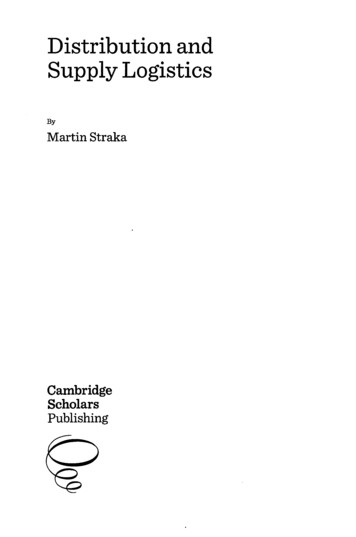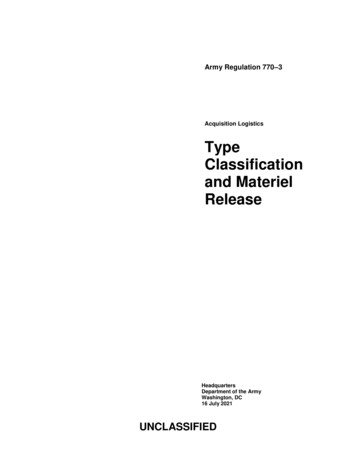
Transcription
Army Regulation 770–3Acquisition LogisticsTypeClassificationand MaterielReleaseHeadquartersDepartment of the ArmyWashington, DC16 July 2021UNCLASSIFIED
SUMMARYAR 770– 3Type Classification and Materiel ReleaseThis new publication, dated 16 July 2021—oEstablishes the procedures set forth in DA Pam 770 – 3 as mandatory (para 1 – 6).oAuthorizes the program executive officer to approve fielding materiel designated as conditional materiel release(para 1–7d(2)).oAdds Army Geospatial Enterprise policy (paras 1 – 11 and 1–17a(3)).oEstablishes responsibilities for the Commanding General, U.S. Army Futures Command (para 1 – 13).oAdds hazards of electromagnetic radiation to ordnance certification policy (paras 1–17d(12), 3–11c(16), 3–27b(4), and 3–29c(12)).oEstablishes policy for type classifying commercial medical devices (para 2 – 11).oEstablishes conditional materiel release breach policy (para 3 – 24).oEstablishes transition to sustainment conditional materiel release policy (para 3 – 25).oEliminates environmental conformance certification as a type classification requirement (throughout).oEstablishes materiel release policy for programs designated as within adaptive acquisition framework pathwaysmid-tier acquisition (throughout).oReplaces the term “manpower and personnel integration” with “human systems integration” (throughout).oReplaces the term “program manager” with “materiel developer” (throughout).oReplaces the term “Standard Study Number-Line Item Number Automated Management and Integrating System”with “cloud equipping” (throughout).oReplaces the “Department of Defense information assurance certification and accreditation process” with the“risk management framework process” (throughout).oReplaces the “operational test agency milestone assessment report” and “operational test agency evaluationreport” with evaluation or assessment as determined by the U.S. Army Test and Evaluation Command(throughout).
*Army Regulation 770 –3HeadquartersDepartment of the ArmyWashington, DC16 July 2021Effective 16 August 2021Acquisition LogisticsType Classification and Materiel ReleaseProponent and exception authority.The proponent of this regulation is the Assistant Secretary of the Army (Acquisition, Logistics and Technology). The proponent has the authority to approve exceptions or waivers to this regulation thatare consistent with controlling law andregulations. The proponent may delegatethis approval authority, in writing, to a division chief within the proponent agencyor its direct reporting unit or field operating agency, in the grade of colonel or thecivilian equivalent. Activities may requesta waiver to this regulation by providingjustification that includes a full analysis ofHistory. This publication is a new De- the expected benefits and must includepartment of the Army regulation.formal review by the activity’s senior leSummary. This regulation prescribes gal officer. All waiver requests will be enresponsibilities and policy for type classi- dorsed by the commander or senior leaderof the requesting activity and forwardedfication and materiel release.through their higher headquarters to theApplicability. This regulation applies policy proponent. Refer to AR 25 – 30 forto the Regular Army, the Army National specific guidance.Guard/Army National Guard of theUnited States, and the U.S. Army Re- Army internal control process.This regulation contains internal controlserve, unless otherwise stated.provisions in accordance with AR 11 –2and identifies key internal controls thatmust be evaluated (see app B).Supplementation. Supplementationof this regulation and establishment ofagency, command, and installation formsare prohibited without prior approvalfrom the Assistant Secretary of the Army(Acquisition, Logistics and Technology)(SAAL– ZL), 103 Army Pentagon, Washington, DC 20310 – 0103.Suggested improvements. Usersare invited to send comments and suggested improvements on DA Form 2028(Recommended Changes to Publicationsand Blank Forms) directly to the AssistantSecretary of the Army (Acquisition, Logistics and Technology) (SAAL – ZL), 103Army Pentagon, Washington, DC20310– 0103.Distribution. This regulation is available in electronic media only and is intended for the Regular Army, the ArmyNational Guard/Army National Guard ofthe United States, and the U.S. Army Reserve.Contents (Listed by paragraph and page number)Chapter 1General, page 1Section IIntroduction, page 1Purpose 1 – 1, page 1References and forms 1 – 2, page 1Explanation of abbreviations and terms 1 – 3, page 1Responsibilities 1 – 4, page 1Records management (recordkeeping) requirements 1 – 5, page 1Mandatory procedures 1 – 6, page 1Section IIResponsibilities, page 1Assistant Secretary of the Army (Acquisition, Logistics and Technology) 1 – 7, page 1Assistant Secretary of the Army (Installations, Energy and Environment) 1 – 8, page 2Deputy Chief of Staff, G – 1 1 – 9, page 2Deputy Chief of Staff, G – 6 1 – 10, page 2Chief of Engineers 1 – 11, page 2*This regulation supersedes AR 700-142, dated 26 February 2020.AR 770–3 16 July 2021UNCLASSIFIEDi
Contents—ContinuedThe Surgeon General 1 – 12, page 2Commanding General, U.S. Army Futures Command 1 – 13, page 2Commanding General, U.S. Army Materiel Command 1 – 14, page 2Commanding General, U.S. Army Test and Evaluation Command 1 – 15, page 3Commanding General, Military Surface Deployment and Distribution Command 1 – 16, page 3Materiel developer 1 – 17, page 3Capability developers and trainers 1 – 18, page 5Chapter 2Type Classification, page 5Section IProcess and Applicability, page 5Process 2 – 1, page 5Materiel applicability 2 – 2, page 5Materiel non-applicability 2 – 3, page 6Modification and upgrade of materiel 2 – 4, page 7Section IIPolicy, page 7General 2 – 5, page 7Approval authority 2 – 6, page 8Type classification prohibitions 2 – 7, page 8Designations 2 – 8, page 8Section IIIRequirements, page 9Requirements for type classification (activities or documents) 2 – 9, page 9Initial type classification assignment request 2 – 10, page 9Section IVRelated Policy, page 9Commercial medical devices 2 – 11, page 9Basis of issue plan 2 – 12, page 10Developmental line item numbers 2 – 13, page 10Chapter 3Materiel Release, page 10Section IProcess and Applicability, page 10Process 3 – 1, page 10Materiel applicability 3 – 2, page 11Materiel non-applicability 3 – 3, page 11Modification, upgrade, and reprocurement of materiel 3 – 4, page 12Section IIPolicy, page 12General 3 – 5, page 12Training devices 3 – 6, page 13Materiel release of evolutionary acquisition programs 3 – 7, page 13Section IIIAuthorities and Designations, page 14Materiel release authorities 3 – 8, page 14Functional authorities 3 – 9, page 14Designations 3 – 10, page 14AR 770–3 16 July 2021ii
Contents—ContinuedSection IVFull Materiel Release Activities, Documents, and Requirements, page 15Safety activities, documents, and requirements 3 – 11, page 15Suitability activities, documents, and requirements 3 – 12, page 16Supportability activities, documents, and requirements 3 – 13, page 16Section VConditional Materiel Release, page 17Activities, Documents, and Requirements 3 – 14, page 17Get-well plan 3 – 15, page 18Materiel release packages and initiation 3 – 16, page 18Condition get-well date extension 3 – 17, page 19Condition closure 3 – 18, page 19Follow-on conditional materiel release 3 – 19, page 19Conversion from conditional materiel release to full materiel release 3 – 20, page 20Prepositioning of materiel 3 – 21, page 20Materiel Release Tracking System 3 – 22, page 20Readiness for issue certification 3 – 23, page 21Conditional materiel release breach 3 – 24, page 21Transition to sustainment (conditional materiel release) 3 – 25, page 21Section VIUrgent and Training Materiel Release, page 22Urgent materiel release 3 – 26, page 22Urgent materiel release activities, documents, and requirements 3 – 27, page 23Training materiel release 3 – 28, page 24Training materiel release activities, documents, and requirements 3 – 29, page 25Tests, demonstrations, pilots, and training 3 – 30, page 25Section VIISoftware Materiel Release, page 26Software materiel release 3 – 31, page 26Software materiel release criteria 3 – 32, page 27Safety activities, documents, and requirements 3 – 33, page 27Suitability activities, documents, and requirements 3 – 34, page 27Supportability activities, documents, and requirements 3 – 35, page 28Software release (other than materiel release) 3 – 36, page 28AppendixesA. References, page 30B. Internal Control Evaluation, page 33GlossaryAR 770–3 16 July 2021iii
Chapter 1GeneralSection IIntroduction1–1. PurposeThis regulation assigns responsibilities and establishes policy for type classification (TC) and materiel release (MR).1–2. References and formsSee appendix A.1–3. Explanation of abbreviations and termsSee the glossary.1–4. ResponsibilitiesResponsibilities are listed in section II of chapter 1.1–5. Records management (recordkeeping) requirementsThe records management requirement for all record numbers, associated forms, and reports required by this regulationare addressed in the Records Retention Schedule-Army (RRS – A). Detailed information for all related record numbers,forms, and reports are located in Army Records Information Management System (ARIMS)/RRS – A athttps://www.arims.army.mil. If any record numbers, forms, and reports are not current, addressed, and/or publishedcorrectly in ARIMS/RRS – A, see DA Pam 25 – 403 for guidance.1–6. Mandatory proceduresThis regulation will be used in conjunction with DA Pam 770 – 3. The tables, notes, and procedures in DA Pam 770 – 3to determine materiel TC and MR applicability, activities, documents, requirements, and designations are mandatoryand therefore required to execute the policy set forth in this regulation in accordance with AR 25 – 30.Section IIResponsibilities1–7. Assistant Secretary of the Army (Acquisition, Logistics and Technology)The ASA (ALT) will—a. Develop TC and MR policies and procedures.b. Provide clarification of TC and MR policy applicability, as required.c. When serving as the Army Acquisition Executive, approve high-risk MR safety conditions, if justified.d. Provide TC and MR policy execution responsibilities to the program executive officer (PEO). The PEO—(1) Will resolve get-well plans for materiel designated as conditional materiel release (CMR).(2) Is authorized to approve materiel systems designated as CMR by the appropriate materiel release authority(MRA) to be fielded and proceed to full-rate production (FRP) reviews for decision.(3) Will serve as the type classified standard (TC – STD), TC limited procurement (LP) and TC exempt approvalauthority for acquisition programs for which they oversee materiel development.e. Through the Joint Program Executive Officer for Chemical, Biological, Radiological and Nuclear Defense(JPEO CBRND), serve as the MRA for all chemical, biological, radiological, and nuclear technology, materiel, medicines, and medical devices for which they oversee materiel development.f. Through the Program Executive Officer for Simulation, Training, and Instrumentation (PEO STRI), serve as theMRA for training aids, devices, simulators, and simulations (TADSS), instrumentation, targets, and threat simulatorsfor training, testing, and combat training center instrumentation for which they oversee materiel development.AR 770–3 16 July 20211
1–8. Assistant Secretary of the Army (Installations, Energy and Environment)The ASA (IE&E) is the environment, safety and occupational health (ESOH) proponent for Army installation management issues and will ensure applicable environmental requirements, including environmental compliance, hazardous materiel, and pollution-prevention opportunities, are considered as part of materiel development and sustainment.1–9. Deputy Chief of Staff, G –1The DCS, G– 1 will assign responsibility to the U.S. Army Combat Capabilities Development Command (DEVCOM)Data and Analysis Center (DAC) to serve on behalf of the DCS, G – 1 and identify human systems integration (HSI)issues in materiel systems and provide the materiel developer (MATDEV) an HSI assessment in support of MR (seeAR 602 – 2).1–10. Deputy Chief of Staff, G –6The DCS, G– 6 is the approval authority for Army interoperability certification (AIC).1–11. Chief of EngineersThe COE will coordinate with the ASA (ALT); DCS, G – 6; DCS, G– 3/5/7; and Commanding General (CG), U.S.Army Test and Evaluation Command (ATEC) to ensure systems that produce or exchange geospatially referenceddata are tested and certified for Army Geospatial Enterprise compliance (see AR 115 – 11).1–12. The Surgeon GeneralTSG will serve as the MRA for medical materiel (devices) and coordinate with other MATDEVs to identify potentialhealth hazards in nonmedical materiel (devices) as applicable (see AR 40 – 10). If desired, TSG is authorized to transferMRA responsibilities for medical materiel (devices) to the U.S. Army Medical Logistics Command or other currentMRA. If the TSG elects to transfer MRA responsibilities, the incoming MRA will assume the responsibilities identified in paragraphs 1–14g(1) through 1–14g(7) as applicable for medical materiel (devices) and other related policiesand procedures inherent to serving as a MRA or applicable functional authority (FA) for medical materiel (devices).1–13. Commanding General, U.S. Army Futures CommandThe CG, AFC will—a. Assist the ASA (ALT) with developing TC and MR policies and procedures.b. Determine the impacts of MR decisions on modernization plans, if applicable.c. Participate in forums that focus on closing MR suitability conditions.d. Issue statements of supportability for explosive ordnance disposal (EOD) through the DEVCOM.1–14. Commanding General, U.S. Army Materiel CommandThe CG, AMC will—a. Manage and oversee the execution of the Army MR program for Army materiel, except for systems procured byU.S. Army Network Enterprise Technology Command, U.S. Army Cyber Command, JPEO CBRND, PEO STRI, theCorps of Engineers, or TSG, unless TSG has transferred MRA authority. In this case, this policy would apply to theincoming MRA.b. Monitor the Army MR process to ensure effective execution.c. Assist the ASA (ALT) with developing TC and MR policies and safety-related activities within the MR process.d. Release all materiel through the MRA when materiel meets the requirements outlined in this policy.e. When requested, resolve MR issues and nonconcurrences between organizations and agencies.f. Ensure statements of EOD supportability are issued by the AFC EOD staff officer. An EOD supportability statement and a readiness for issue certification (RFIC) will be issued for the release of new materiel when the materielcontains energetic materials.g. Through the appropriate CG, AMC life cycle management commands (LCMCs)—(1) Serve as the MRA for all acquisition programs, systems, and equipment managed by the ASA (ALT), PEOs orMATDEVs, except for cases where this regulation grants MR authority to the PEO, Joint PEO, U.S. Army NetworkEnterprise Technology Command, U.S. Army Cyber Command, Corps of Engineers, or TSG, unless TSG has transferred MRA authority.(2) Approve and process the materiel status record (MSR) submission to update the Supply Bulletin (SB) 700 – 20in support of force development documentation.(3) Manage a formal MR process in accordance with this regulation.AR 770–3 16 July 20212
(4) Notify storage activities to reclassify materiel to the appropriate condition code and ownership purpose codewhen MR actions are complete.(5) Participate in forums that focus on closing MR supportability conditions.(a) Designate an organization responsible to manage the MR process within subordinate commands.(b) Verify that all requirements for release are met, documented, and auditable.(c) Ensure that MR data is updated on a regular basis and is maintained in the Materiel Release Tracking System(MRTS) to reflect all forecasted MRs and get-well plans.(6) Provide the MATDEV supportability statements for assigned materiel used as part of or fielded with othermateriel systems, such as component of end item (COEI) and associated support items of equipment (ASIOE).(7) Provide support to the designated MATDEV in support of the MR and nonstandard urgent materiel release(UMR) requests.h. Through the Commander, Joint Munitions Command (JMC), serve as the MRA for all munitions (excludingmissiles).i. Integrate AFC into the MR staffing process as required.1–15. Commanding General, U.S. Army Test and Evaluation CommandThe CG, ATEC will—a. Provide a safety release before the start of training, testing, maintenance, or demonstrations that use Soldiers asparticipants.b. Provide safety confirmations for milestone, MR, fielding, and equipping decision reviews.c. Compare materiel test, inspection, and modeling and simulation results against capability document requirements.d. Provide the MATDEV an evaluation or assessment of the materiel solution to support milestone and MR, fielding, equipping decision reviews.e. Provide a notification memorandum to the MATDEV for those low-risk programs where an evaluation or assessment will not be conducted.f. Provide the MATDEV a memorandum that presents a position relative to the proposed MR and lists the factors,if any that would prevent a full materiel release (FMR).g. Participate in the MR process throughout materiel life cycle events.h. Identify opportunities in MATDEV MR planning and milestone documents to apply data from multiple sourcessuch as lab tests performed with users, modeling and simulation, contractor test, foreign comparative test, operationaluser assessments, and other data sources to support tailoring operational test requirements in preparation for MR.1–16. Commanding General, Military Surface Deployment and Distribution CommandThe CG, SDDC will—a. Provide transportability policy, guidance, engineering analysis, and evaluation in support of TC and MR.b. Provide transportability approval in support of the MR process in accordance with AR 70 – 1 and AR 70 – 47.c. Provide specific continental United States or outside continental United States shipping and handling instructionsand onsite enforcement of that policy in support of MR.1–17. Materiel developerThe MATDEV is responsible for each of the following areas:a. General. The MATDEV will—(1) For munitions, ensure a draft demilitarization and disposal plan is available for coordination with the projectdirector for demilitarization at Milestone B and an approved demilitarization and disposal plan is available not laterthan the TC– STD designation and Milestone C.(2) For munitions, ensure a draft demilitarization and disposal depot maintenance work requirement plan is available not later than the FMR decision.(3) Ensure compliance with Army Geospatial Enterprise certification requirements (see AR 115 – 11).(4) Execute requirements for transition to sustainment (T2S) CMR identified in paragraph 3 – 25.(5) Execute the requirements for a CMR breach identified in paragraph 3 – 24.b. Type classification. For TC, the MATDEV will—(1) Accomplish TC as part of an integrated process team (IPT), when appropriate.(2) Submit an MSR to document TC and update the SB 700 – 20 using the automated TC or MSR process in thecloud equipping (cQuiP) system.AR 770–3 16 July 20213
(3) Request TC– STD for all materiel entering the Army inventory whenever possible and document exceptionsusing other TC designations.c. Materiel release. For MR, the MATDEV will—(1) Develop a MR strategy to achieve FMR.(2) Integrate HSI into MR planning early in the acquisition life cycle (see AR 602 – 2).(3) Prior to the system design phase, contact the DEVCOM DAC HSI representative to ensure they are generatingthe HSI plan and monitoring of the HSI plan is being conducted for the particular system.(4) Ensure that a plan for MR is included in the life cycle sustainment plan (LCSP) or product support strategyoutlining the timeline for satisfying each MR requirement.(5) Provide input to the materiel release office (MRO) in MRTS for MR forecasts and get-well plans.(6) Provide the MRO with changes to the MRTS on a quarterly basis.(7) Notify the applicable commands whenever get-well plans are revised.(8) Provide required documentation for all MR requests. This includes obtaining an acceptance of conditions andurgency-of-need statement from the gaining command (GC) for all CMR actions.(9) Request approval from the MRA to release materiel.(10) Execute the development and fielding of corresponding TADSS as part of the materiel system MR strategy.(11) Conduct the MR process in an IPT that will include the applicable MRO representative.(12) Ensure coordination of release actions with the LCMCs responsible for support and ancillary equipment anddocument their MR support statements.(13) Obtain MRA approval (or designated representative) for changes to get-well dates and notify the GC whenapproval is obtained.(14) Have an oversight method to review materiel designated as CMR to ensure conditions are resolved in accordance with the approved get-well plan.d. Safety. To ensure safety, the MATDEV will—(1) Ensure the materiel and associated logistics support products meet applicable ESOH requirements and thatacceptance of associated risks for residual safety hazards is properly documented in accordance with AR 385 – 10, DAPam 385 – 16, and MIL– STD–882E.(2) Coordinate with the MRA supporting safety office and ATEC to determine whether software changes willaffect the safety of the total system and whether an amended safety confirmation is required.(3) If required, coordinate with the supporting radiation safety officer to obtain Nuclear Regulatory Commission(NRC) and Army radiation authorizations in accordance with Title 10, Code of Federal Regulations (10 CFR) and DAPam 385 – 24.(4) Provide the DEVCOM Armaments Center (EOD Technology Division) all technical data on systems that useenergetic materials a minimum of 180 days prior to the MR date.(5) Ensure the system has a final hazard classification in accordance with 49 CFR 173.(6) Ensure the safety statement (Safety and Health Data Sheet) is included within the MR package.(7) Request a safety confirmation from ATEC as part of required MR documentation. In cases where the U.S.Army Intelligence and Security Command or U.S. Special Forces are the single user, they may perform their owntesting and do not need a safety confirmation from ATEC.(8) When materiel is reprocured, the MATDEV, in conjunction with the MRA supporting safety office subjectmatter expert, shall ensure the appropriate testing occurred and that safety and health evaluations are performed toverify that the safety characteristics of the original configuration are not compromised and that no new hazards areintroduced. These evaluations will be conducted during the initial production tests or other testing.(9) Ensure that lasers or laser systems comply with the provisions of 21 CFR 1040.10 and 21 CFR 1040.11.(10) Ensure the DoD laser exemption notification is in place prior to purchase and lasers or laser systems areproperly labeled and tracked (see MIL – STD– 1425A and American National Standards Institute (ANSI) Z136.6 forguidance on the military exempt laser process).(11) Test and evaluate the system to ensure compliance with applicable environmental regulations.(12) Ensure munitions development complies with hazards of electromagnetic radiation to ordnance (HERO) evaluation and certification requirements (see AR 385 – 10).e. Suitability. To ensure suitability, the MATDEV will—(1) Ensure that the total system is tested in accordance with AR 73 – 1 in the configuration in which it will be fieldedand that the evaluation process is complete.(2) Ensure that critical and major test incidents disclosed during government or contractor testing are resolved orprovisions made for resolution.(3) Obtain from ATEC their evaluation or assessment and a safety confirmation, if needed.AR 770–3 16 July 20214
(4) Coordinate with ATEC to ensure materiel systems adequately meet system requirements.(5) Ensure training devices for initial fielding and sustainment are type classified, safe, suitable, and supportable.(6) Ensure embedded (permanently fixed and non-removable) training devices are included as part of the system’sTC and MR effort.(7) Obtain transportability approval from SDDC Transportation Engineering Agency (TEA) prior to Milestone C.(8) Obtain DCS, G– 6 AIC determination, which can result in a certification, exemption, or waiver. Ensure that—(a) All cybersecurity requirements are properly implemented and consistent with Army policy before the systemis released, or that a plan of action and milestones is approved by the appropriate authority before the system is released.(b) Each system achieves the appropriate level of protection for applicable system security requirements.(9) Use the risk management framework (RMF) process to implement cybersecurity measures throughout the system life cycle.(10) Ensure non-DoD and inter-Service user requirements are taken into consideration during the engineering andmanufacturing development phase.f. Supportability. To ensure supportability, the MATDEV will—(1) Ensure that materiel is logistically supportable in its fielded configuration and user’s environment as outlinedin the LCSP and materiel fielding plans, when applicable.(2) Obtain a test, measurement and diagnostic equipment (TMDE) supportability statement from the ExecutiveDirector, U.S. Army Test, Measurement and Diagnostic Equipment Activity (USATA) in accordance with AR750 – 43, when applicable.(3) Coordinate with the supporting DEVCOM engineering activity to obtain software suitability and supportabilitystatements and the MRA supporting safety office to obtain software safety statement to ensure these are factored inthroughout the system life cycle.(4) Coordinate the use of existing Army standard automated test equipment (ATE) with the TMDE project directorfor nonembedded solutions prior to developing a new ATE solution.(5) Ensure training (both hardware and software) for all personnel, including logistics assistance representativesand field software engineers, is adequate to support the materiel.(6) Coordinate with the central tool manager and adhere to policy for common and special tool procurements (seeAR 700 – 127).(7) Ensure training requirements include operation and maintenance of the system for both field and sustainmentlevel and system-peculiar logistics support requirements.1–18. Capability developers and trainersCapability developers (CAPDEVs) will participate in the MR review process and provide the MATDEV written acceptance or nonacceptance of materiel planned for a training materiel release (TMR). An acceptance of issues andrestrictions for use signed by a general officer or civilian equivalent will accompany the concurrence for a trainingrelease.Chapter 2Type ClassificationSection IProcess and Applicability2–1. ProcessThe TC process provides data for authorization, logistics support, asset visibility, maintenance, and readiness reportingand integrates the acquisition process with standard Army logistics processes that lead to production and fielding.2–2. Materiel applicabilityThe following materiel requires TC:a. Nonexpendable materiel described as materiel separately authorized by table of organization and equipment(TOE), modified table of organization and equipment (MTOE), table of distribution and allowances (TDA), joint tableof allowances (JTA), and common tables of allowances (CTA).AR 770–3 16 July 20215
b. High-density military expendables (munitions and combat rations). Another Service’s fielded ammunition thathas achieved a Milestone C, if adopted by the Army without configuration changes, requires a TC validation memorandum documenting this approach from the MATDEV to the PEO.c. Materiel procured by the Defense Logistics Agency (DLA) and developed by the Army.d. Jointly developed materiel where the Army is a user of the materiel developed jointly and in the joint memorandum of agreement as required by Army policy.e. Materiel procured by another military Service or Government agency where the Army is a user of the materiel.f. Commercial medical devices (see para 2 – 11).g. Clothing and individual equipment listed in the CTA.h. Fixed site strategic communications systems on an MTOE and standard line item number (LIN).i. Test equipment modernization described as nondevelopmental test equipment modernization or general purposeelectronic test equipment as outlined in AR 750 – 43.j. Soldier portable sets, kits, outfits, and tools (SKOT) described as assemblages of nondevelopmental tools andsupplies hand carried by Soldiers.k. Nondevelopmental support equipment described as equipment including lathes, mills, drill presses, compressors,standalone welders, or welding machines that do not introduce significant safety, suitability, transportability, or supportability issues.l. Nondevelopmental cryptographic materiel described as materiel using an algorithm certified by National Security Agency under the Commercial Communication Security Evaluation Program.m. All mission-related items authorized by CTA will meet TC requirements.2–3. Materiel non-applicabilitya. The following materiel does not require TC:(1) Limited distribution materiel described as—(a) JTA or TDA unit and other Service-adopted materiel that DLA is responsible to certify production.(b) Restricted issue materiel to schools and training centers, laboratories, and maintenance and test activities.(c) Nondevelopmental materiel authorized only by JTA or TDA and not supported by the Army supply system.(d) EOD disposal tools, equipment, and associated SKOT restricted to JTA or TDA, schools, training cente
Materiel Release Tracking System 3 - 22, page 20 Readiness for issue certification 3 - 23, page 21 Conditional materiel release breach 3 - 24, page 21 Transition to sustainment (conditional materiel release) 3 - 25, page 21 Section VI Urgent and Training Materiel Release, page 22 Urgent materiel release 3 - 26, page 22
